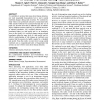Free Online Productivity Tools
i2Speak
i2Symbol
i2OCR
iTex2Img
iWeb2Print
iWeb2Shot
i2Type
iPdf2Split
iPdf2Merge
i2Bopomofo
i2Arabic
i2Style
i2Image
i2PDF
iLatex2Rtf
Sci2ools
CHI
2005
ACM
2005
ACM
Towards an index of opportunity: understanding changes in mental workload during task execution
To contribute to systems that reason about human attention, our work empirically demonstrates how a user's mental workload changes during task execution. We conducted a study where users performed interactive, hierarchical tasks while mental workload was measured through the use of pupil size. Results show that (i) different types of subtasks impose different mental workload, (ii) workload decreases at subtask boundaries, (iii) workload decreases more at boundaries higher in a task model and less at boundaries lower in the model, (iv) workload changes among subtask boundaries within the same level of a task model, and (v) effective understanding of why changes in workload occur requires that the measure be tightly coupled to a validated task model. From the results, we show how to map mental workload onto a computational Index of Opportunity that systems can use to better reason about human attention. KEYWORDS Attention, Interruption, Pupil size, Task models CATEGORIES AND SUBJEC...
CHI 2005 | Human Computer Interaction | Mental Workload Changes | Workload Decreases | Workload Occur |
| Added | 30 Nov 2009 |
| Updated | 30 Nov 2009 |
| Type | Conference |
| Year | 2005 |
| Where | CHI |
| Authors | Shamsi T. Iqbal, Piotr D. Adamczyk, Xianjun Sam Zheng, Brian P. Bailey |
Comments (0)

